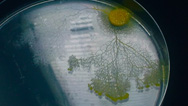The Waggle Dance
- Posted 11.08.12
- NOVA scienceNOW
(This video is no longer available for streaming.) Honeybees communicate using the "waggle dance," a form of bee body language. A worker bee will shake her body after finding a food source or potential nest site. The direction and length of each shimmy indicates to her hivemates the distance and direction of the valuable resource. Watch as David Pogue learns to speak bee and gets his waggle on.
Transcript
The Waggle Dance
Posted: November 8, 2012
Narrator: To the untrained eye, this swarm of bees looks like a mass of squirming bugs, but a closer inspection reveals something amazing going on, and it has a crazy name.
David Pogue: Did I just hear a scientist say waggle dances?
Tom Seeley: Yes.
Narrator: Tom Seeley is a bee expert at Cornell University, and he's about to show me one of the most famous animal "languages" in the natural world.
Tom Seeley: As she waggles she's indicating the direction and distance to a potential home site to all of the other bees that you see tripping around behind her.
David Pogue: What? That's—it's just vibrating, dude. How can that bee communicate something so specific just by shaking its little bee butt?
Narrator: As it turns out, a few wiggles of those striped butts can say a lot. The waggle dance is the way bees communicate with each other, and its discovery in the 1940s was so astounding it won a Nobel Prize.
Tom Seeley: That kind of ability is very, very special. Well, you and I can do it. And bees can do it. But there are almost no other species on the planet that can do that.
Narrator: Bees use the waggle dance to communicate the precise location of food sources and home sites to their hivemates.
See this yellow-painted bee here—see how every time she wiggles she's facing the same direction? She's actually pointing her hivemates in the direction to fly relative to the sun to find a new home site. And the length of time she spends wiggling is how far to fly: about a half second of dancing equals a half-kilometer of flight distance. It's one of the few animal "languages" ever decoded, and our host David Pogue is about to become fluent.
David Pogue: Ah ah—this looks like one of your grad student slaves. Hi. David.
Michael Smith: Michael.
David Pogue: So how exactly does the waggle dance work?
Michael Smith: So the waggle dance will work with a waggle run, which will point in the direction of the box that you prefer that you visited and you like. And then if it's a nest site that's a short distance, she'll do a short waggle. If it's a long distance, she'll do a much longer waggle. But the actual pointing of the waggle will show where the nest box actually is. So she gets two things out of it—direction and distance.
Well, first you need your bee goggles to make it really professional.
David Pogue: To protect us from the harmful rays of anyone watching us.
I will be doing this? Isn't this a job better left to the pros?
Michael Smith: No no, this is a job for all worker honey bees.
Ok, so here we go. I'm gonna shake my money maker and I'm gonna make it happen. Get ready, you know, loosen it up. Shake it! And then come back around, and then shake it! And then we'll come back around. And that's a circuit right there.
So shake it, waggle, and come back around.
David Pogue: Dude, did you say you're in graduate school?
Michael Smith: Yeah, I really don't know how that happened.
Credits
PRODUCTION CREDITS
- Written and Produced by
- Anna Lee Strachan
- Edited by
- Daniel Gaucher
- Original Footage
- © WGBH Educational Foundation 2012
IMAGE
- (bees)
- © WGBH Educational Foundation 2012
Related Links
-

What Are Animals Thinking?
Probe animal morality, the "swarm intelligence" of a beehive, the amazing navigation talents of pigeons, and more.
-

Slime Mold Smarts
Slime molds may be brainless, but they aren't stupid.
-

Emergence
How does the "intelligence" of an ant colony or the stock market arise out of the simple actions of its members?
-

Dogs' Dazzling Sense of Smell
What lies behind their exceptional gift of sniff?



